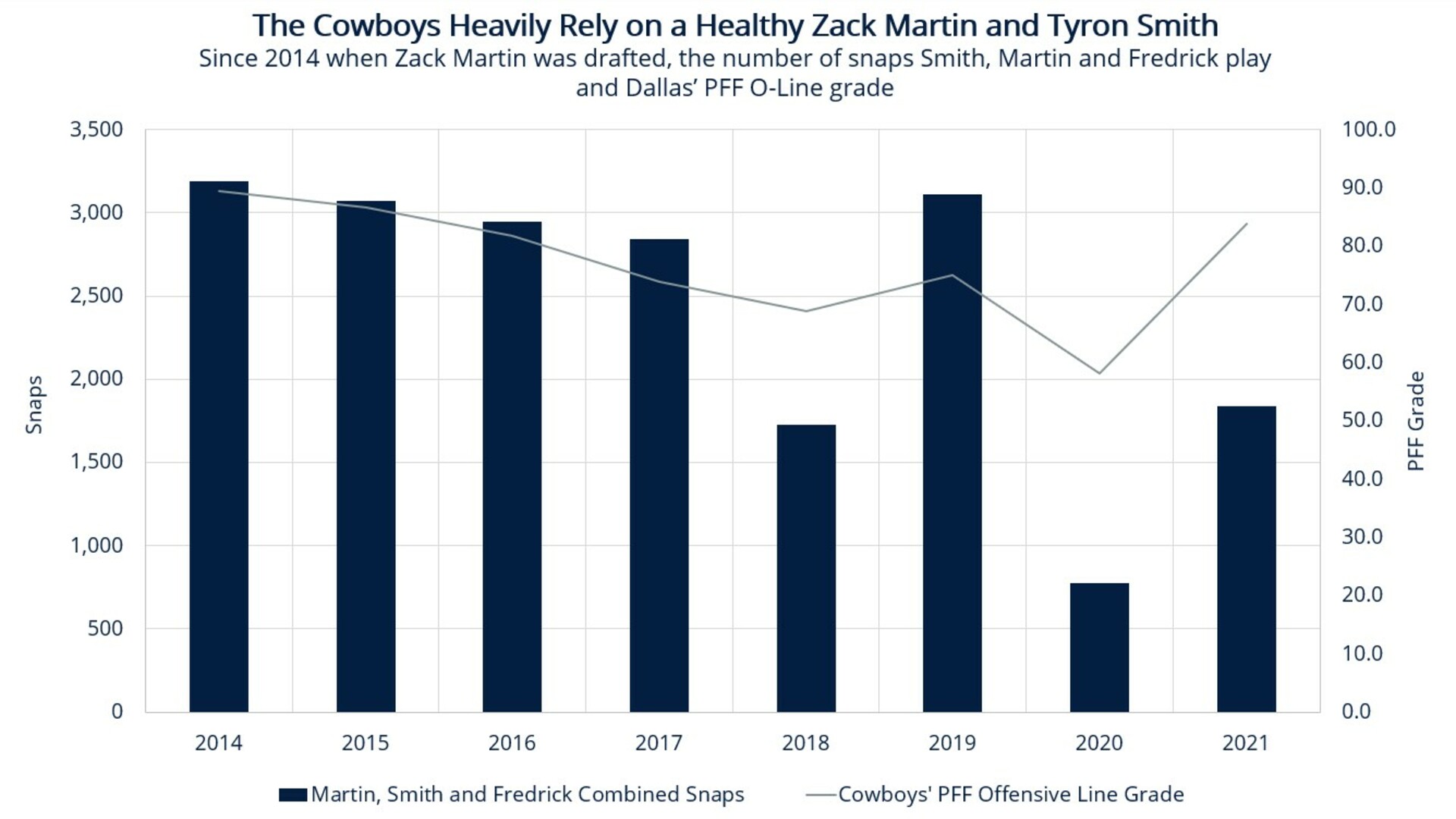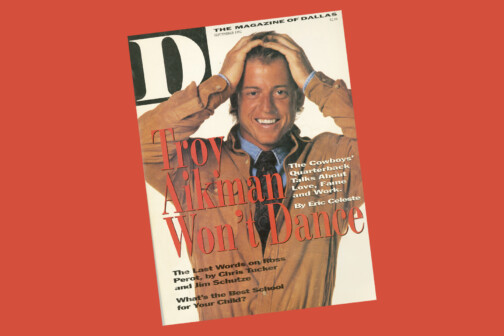Over the past 10 years, the Cowboys have been all over the map, running the gamut from miserable to mediocre to occasionally excellent. Through the roller coaster of hope and frustration, there was one constant: the offensive line consistently produced. But what was once the team’s biggest strength might now be its biggest wild card.
The group reached its peak in 2016, when the front five boasted three first-team All-Pro selections. Ever since Zack Martin joined fellow first-round draft picks Tyron Smith and Travis Fredrick in 2014, Dallas repeatedly ranked among the league leaders in offensive line performance. The front five was instrumental in turning DeMarco Murray into a 1,845-yard rusher and Ezekiel Elliott into a three-time Pro Bowler. It even paved the way for Darren McFadden to surpass 1,000 yards in 2015.
But nothing lasts forever. In March 2020, Fredrick announced his retirement due to a nerve disorder that had sidelined him for the 2018 season. In the two seasons since, Smith appeared in just 14 of 34 games. Martin has not slowed down, reaching All-Pro status for the fifth time in his career last season. While Smith and Martin still dominate when they play, however, it is evident that the era of a dominating Dallas front five is over. The team knows it, too: in the 2022 NFL Draft, the Cowboys selected an offensive lineman in the first round for the first time since taking Martin.
If Dallas wants to contend, the front five must recapture the old magic. Though the offensive line was a top-five unit last season according to Pro Football Focus, it was wildly inconsistent. Dak Prescott faced the sixth-most pressures in the league, and the Cowboys’ 4.1 yards per rush attempt in the 11 regular-season games after the bye was around the league average. The offensive line contributed to the early postseason exit, too. Prescott was pressured 25 times in the wild-card loss to the 49ers. To put that into perspective, Joe Burrow, playing behind a shaky line and against one of the better defensive fronts, was only pressured 18 times in the Bengals’ Super Bowl defeat against the Rams. With the season on the line, Prescott was running for his life.
So the million-dollar question: what will the offensive line look like in 2022? To answer, every player must be considered separately because a front five is different from a wide receiver or linebacking corps where one dominant player can elevate the rest. If a team has four talented linemen and one struggling player, defenses will exploit the weak link. Thus this becomes an exercise in identifying the weak link and determining the effect he could have on the 2022 season.
Let’s start by getting Martin out of the way. He is obviously not that weak link. In 2021 he finished in the top 10 among guards in sacks allowed, QB hurries allowed, pass-blocking efficiency, and penalties committed, and he was PFF’s highest-graded guard. Martin is 31, and that shouldn’t be overlooked. That said, there is no evidence to suggest he has lost a step.
The story is similar with Smith, who is also 31. He was the second-best tackle in the league in 2021 according to PFF. In fact, based on his run-blocking grade, QB hurries allowed, and pressures allowed, Smith had the best season of his career last year. But for the sixth year in a row, he failed to reach 14 games played. Last year alone, 22 tackles exceeded 1,000 snaps played; Smith hasn’t reached that mark since his fifth year in the league, in 2015. La’el Collins is gone and Terence Steele is the full-time right tackle, meaning that a Smith injury would affect the team significantly more this year than in previous seasons. That’s especially true when his likely backups, Matt Waletzko and Josh Ball, have yet to take a single NFL snap. If the Cowboys expect the line to return to its past success, they’ll need a full season out of Smith.
Then there are the other three potential starters, each of whom comes into 2022 with major performance question marks. There’s Tyler Biadasz, who teeters between looking like a reliable center and someone who must be replaced. He took a significant step forward last season, playing 800 more snaps than in his rookie campaign. On those increased opportunities, he allowed one fewer sack, two more QB hits, and 10 more pressures, and he increased his run-blocking grade by 12.4 points.
But despite that improvement, Biadasz still landed around the league average in grading by PFF. Worst-case scenario, the third-year center plateaus or slightly regresses. In that case, he would become a problem. He finished in the bottom 10 among starting centers in QB hits allowed, QB hurries, and pressures allowed. The leap from his rookie year was impressive, but he still needs to take another step forward. If so, he can be a starting center in the NFL for years to come. If not, he will hurt this team and probably won’t receive a second contract.
As bleak as that sounds, Steele might be an even bigger problem. Like Biadasz, Steele made strides in his second season. Playing a similar number of snaps as in his rookie season, he decreased his sack total by seven, his pressures allowed by 17, and his QB hurries by 10. Even then, he finished 42nd among the 56 tackles who played at least 670 snaps as rated by PFF. It is worth noting he was a better right tackle than left in 2021, and he will be playing the former position full time this season. If Steele can’t improve on his 2021 effort, he most likely will be back on the bench because what we’ve seen from Steele thus far is a player who gets overwhelmed when defenses send multiple players his way, no matter on which side of the line he plays.
The last link is rookie Tyler Smith, who projects to play left guard. Because we don’t have professional data on rookies, historical comparisons must be used. Over the last five years, only 25 percent of starting rookie offensive linemen have graded out at 70 or above in the PFF system, which is a starter-quality grade according to the scale. So for this exercise, let’s assume Smith grades out between 60 and 69, which feels fair given that he’s a first-round pick (albeit a raw one). The linemen who graded in that range in 2021 averaged 2.9 sacks allowed, 24.8 pressures allowed, and 17.6 hurries, and they had a PFF run-blocking grade of 65.6. Each of those numbers would be worse than what Connor Williams and Connor McGovern produced last season at left guard.
Which is to be expected: it typically takes rookie offensive linemen a full season to adjust to the pro game. Just because Tyron Smith, Martin, and Fredrick hit the ground running doesn’t mean Tyler Smith can’t enjoy a fine pro career if his first NFL season is rocky. It just might mean Dallas should have invested in a veteran stopgap instead of handing him a starting role.
The line of the last 10 years is gone. Age, injuries, and unexpected retirements caught up to a once-dominant front five. The Cowboys are in the process of addressing the issue; however, things will probably get worse before they get better. Perfect world? Steele and Biadasz continue to improve, Tyron Smith stays healthy, and Tyler Smith lives up to his first-round price tag.
But the more likely scenario is that at least one weak line is exposed, and the unit struggles to rank in the top half of the league. Jerry and Stephen Jones gambled by not making the offensive line more of a priority in the offseason. The season could hinge on whether that gamble pays off.
Author








